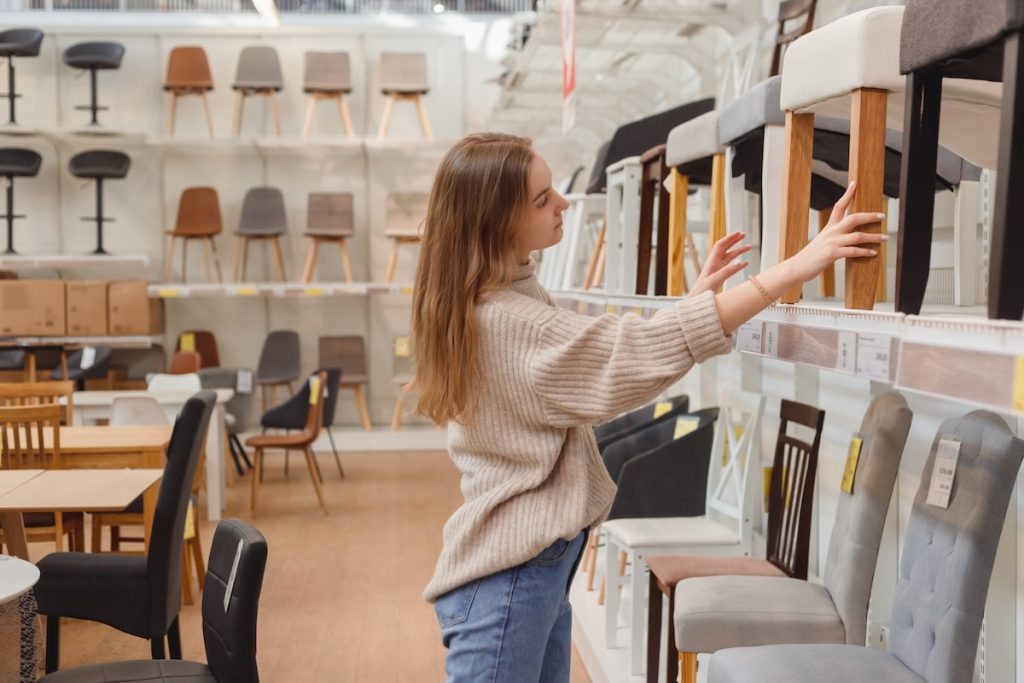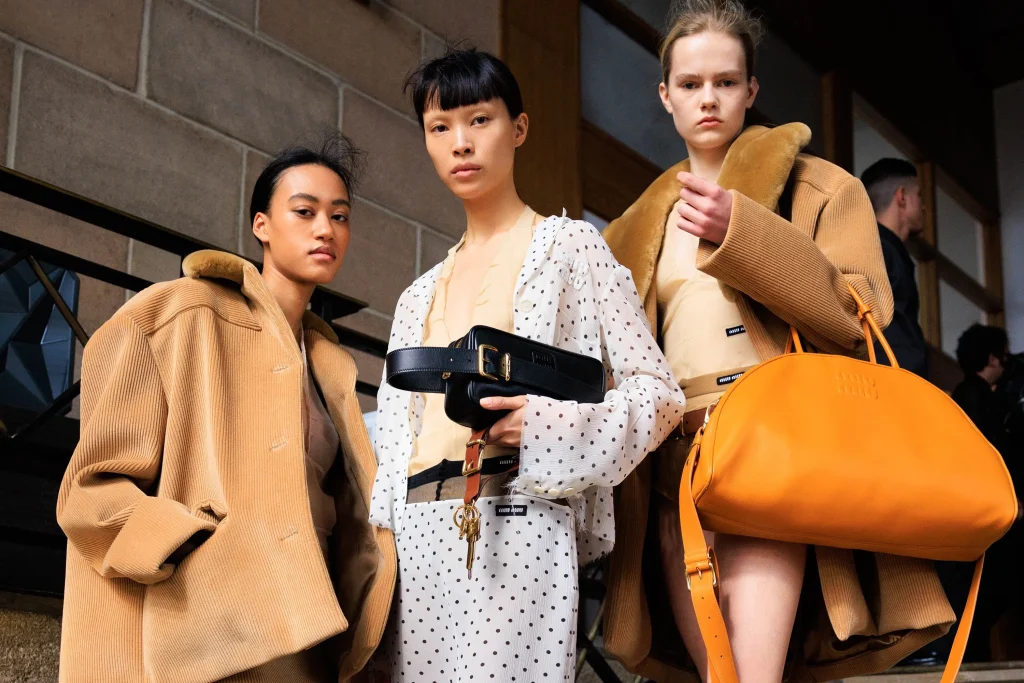The COVID-19 outbreak uncovered a number of supply chain issues as well as other problems with B2B operations.
The switch to internet selling was the silver lining. Moving your entire B2B business online may seem daunting, but those who do so benefit from improved customer experiences, simplified ordering, and new revenue streams for their business.
B2B ecommerce is the process of online product marketing and sales between two firms.
The objective is straightforward: increase client reach while lowering cost-to-serve in order to increase revenue for your company.
What does the future hold for B2B ecommerce, and how do you launch a firm in this sector?
Don’t worry, if you are unfamiliar with this ecommerce model. This article will explain how it functions, how to set up a B2B e-commerce platform, and successful B2B e-commerce case studies to motivate your own initiatives.

How does B2B ecommerce work?
Business-to-business (or B2B) refers to the direct sale of goods and services between two companies.
B2B is a very different business strategy from B2C, which involves companies selling directly to customers.
Through an online sales platform, B2B ecommerce involves transactions between a manufacturer and wholesaler or a wholesaler and a retailer.
One of the sales models with the quickest growth is B2B e-commerce.
According to some estimates, the worldwide B2B ecommerce sector is worth more than $12 trillion and accounts for 13% of all B2B sales in the US.
The shift has been fueled in part by innovation and technology from B2B ecommerce platforms.
B2B transactions have always entailed time-consuming, manual sales and marketing procedures.
Through ecommerce automation, the introduction of digital commerce aids in cost reduction and increased productivity for these organizations.
With the ability to place and manage orders via mobile devices, buyers and sellers can now interact in a single digital space, opening up new channels for companies to find distributors and suppliers.
The wholesale process being automated alters how we assemble teams. It keeps our consumers from waiting to place an order till we are in the office and keeps us from missing orders at 2 a.m. It merely offers so many solutions.
Related Reading: Contextual Commerce – The Future in Digital-Centric Ecommerce
What are the benefits of B2B ecommerce?
– Automated sales procedures among distributors, suppliers, and companies
– Lower costs for the infrastructure and overhead
– Fewer intermediaries required, better growth potential
– Scalable ability to reach a large audience
– 24/7 branding presence across all channels
– Better interactions between partners
– Increased output from the workforce

What are the types of B2B ecommerce?
You’ll probably fit into one of the following three categories if you’re new to B2B ecommerce.
Each has advantages and disadvantages, and many businesses operate in several categories at once.
B2B2C Arrangement
Business-to-business-to-consumer, or B2B2C, is the practice of selling directly to customers. Products are made by manufacturers or wholesalers. These products are subsequently sold to B2B companies who then sell them straight to customers.
A B2B2C company frequently features a digital storefront exhibiting its product catalog in an ecommerce environment. The customer may or may not be aware that the product isn’t made by the company.
Wholesale Arrrangement
In a wholesale arrangement, businesses buy products in large quantities from distributors or manufacturers and then offer them for retail sale to customers.
Buyer-focused B2B marketplaces are an effective approach for wholesale suppliers to promote their goods to consumers and retailers while spending less on marketing.
Where there are more buyers than sellers, there are marketplaces that are geared toward the consumers.
In this instance, buyers have their own online markets. They allow manufacturers and suppliers to display their wares and take offers from various vendors.
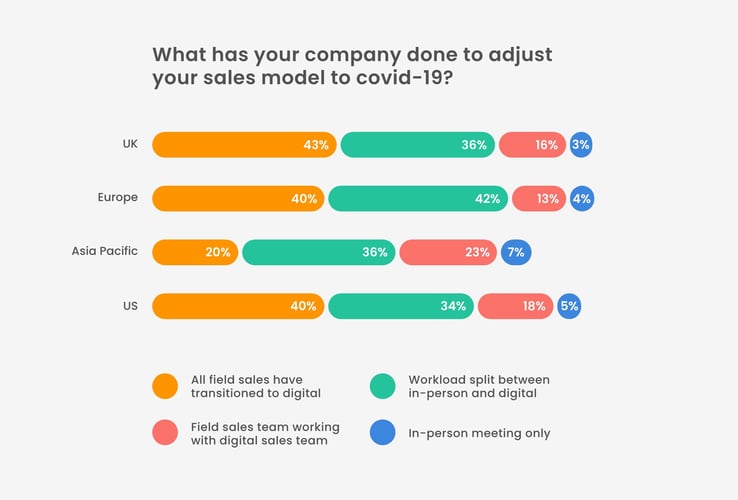
Manufacturer Arrangement
Large quantities of products are produced by manufacturers, who subsequently sell them to suppliers, distributors, or other manufacturers. For instance, a producer may make unique shoelaces.
Following the sale of those shoelaces, a maker of high-end shoes assembles the shoes and adds their branding. From them, distributors can purchase finished shoes in large quantities.
Manufacturers must adapt to the shifting demands of the digital age. Wholesalers, suppliers, other B2B organizations, and consumers want more options when it comes to how they buy produced goods.
Manufacturers must be able to perform online transactions with access to custom features like price, production schedules, or sizing as demand from businesses grows.
Distributor Distributors handle the marketing, packing, and shipping that a manufacturer might not wish to do internally.
To sell their goods, manufacturers have the option of working with distributors.
Online collaboration between a distributor and a manufacturer is possible. The producer and distributor can achieve quicker, more efficient supply chains to meet or exceed client expectations by reaching agreements using an online platform.
As you may expect, it takes competition to gain market share by providing a top-notch client experience.
This necessitates the necessity of optimizing cost-effective distribution initiatives.
Consider Fulfillment by Amazon as an illustration. Today, a lot of startup and established companies choose to outsource their fulfillment processes to Amazon and other cost-efficient e-commerce behemoths.
Related Reading: Shoppable Media – What is it and how it leverages social commerce
What are the stages of a B2B ecommerce business?
Every B2B business journey is different. A few broad phases, however, are experienced by every B2B company as they expand. Here’s a closer look at how a company develops from a startup to an established and successful enterprise.
1. Startup
Consider the startup phase as the phase of inspiration, when all ideas are welcome. You’ve now gone through the ideation process and decided with certainty to launch your B2B ecommerce company.
By selecting an idea, bringing it to life, and making the first few sales, you are testing the market.
The feedback phase is the starting phase. This is the ideal time to be quick and adaptable as you make sales (or don’t make sales) and take in market feedback.
Additionally, a number of important objectives are pertinent throughout the initial phase, such as:
– Using sales to test your minimum viable product
– Ensuring that your business concept provides value and a solution
2. Increasing brand recognition
But achieving these objectives won’t be easy—you’ll face plenty of initial difficulties.
You might learn at this point that your product failed and that your target market isn’t as interested in purchasing what you’re offering.
This occurs because it’s simple to think that you know more about the market than you actually do as a consumer.
On the other hand, things might go completely the other way. You might run out of the few products you made for testing because of the overwhelming demand for your product.
Customers become put off by your out-of-stock notification while you rush to produce more. The latter situation is, admittedly, more often the exception than the rule.
The majority of firms first have trouble making sales but quickly gain momentum. But it’s alright. It doesn’t necessarily imply that your business concept isn’t worthwhile.
You’ll gradually start to notice growth if you pay attention to criticism, try out various product versions, and market to various niches. This moves us to the following phase.
Related Reading: Ecommerce Analytics: Leveraging Data To Unlock Online Sales
3. Growth
A few things are beginning to come together for you at this period of growth. Your sales are rising, becoming more predictable, and you are gaining new clients every day.
Here is when you might start to have some leeway to experiment with deals, potential alliances, and the opportunity to reinvest in the company sectors with the highest ROI.
In the expansion stage, you must also continually review your systems, how you manage supply chains, and how you conduct operations.
At the growth stage, a few objectives are:
– If it’s a part of your growth strategy, look for more investor investment.
– Recruiting important personnel
– Maintaining relationships with suppliers
– Trying out B2B marketing strategies
It can hurt to grow. Because markets shift frequently, your companies may be exposed to shifting customer needs, costly errors, or ferocious competition. However, the growth stage eventually gets your company to the point where it’s ready to develop more aggressively if properly leveraged.
4. Expansion
The growing stage where a hockey stick will appear called the expansion stage. That is, growth only proceeds upward and to the right, as indicated by your sales charts, as cash flow improves, as you surpass break-even, and as you broaden your distribution network.
Depending on your company’s needs as well as those of the market, some typical expansion objectives include:
– Securing top-tier talent
– Creating a long-term customer support strategy
– Improving the sophistication of omnichannel marketing
– Keeping growth steady each quarter
There are still many obstacles at this level of expansion. The odds of strong competition are high, you’re likely vying for market share, and revenue depends on important budgetary choices.
You now have the funds available to invest in overcoming those obstacles and strategically enhancing your product offerings.
5. Maturity
At the mature stage, sales are predictable, future forecasts can be relied upon to maintain cash flow and growth, and hiring is permitted as necessary.
At this point, you probably are:
– Wishing to increase the range of your offerings
– Trying out new markets
– Purchasing modern technologies
– Evaluating possible exit plans
– Increasing the scope of your marketing efforts to maintain growth
Your profit margins are precisely determined during the maturity stage.
You are familiar with your target market, are aware of their preferences, and consistently wow your clients with excellent customer service and a worthwhile offering.
As a business owner, you have the option to change direction, try something new, prepare an exit strategy, or experiment with alternative business models.
You’ve reached a significant turning point at this point. You succeeded. This allows you to relax and rely on routines, well-established business systems, and consistent day-to-day operations that guarantee profitability.
What are the most popular B2B ecommerce marketing tactics?
1. Promote growth with relevant ads
Paid advertisements are still around. Paid advertisements are one of the quickest methods to get momentum in the early phases of growth if you have the beginning funding for them, despite the popularity of social media as a marketing channel for DTC audiences as well as B2B clients.
For illustration, the men’s personal care company Bravo Sierra employed paid Facebook advertisements to increase its clientele.
By increasing its wholesale presence and using a distributor (Amazon) to handle fulfillment, it was able to wean itself off paid advertisements a year later.
2. Buy now, pay later
Consider Klarna, but with business-to-business deals. Businesses can negotiate agreements with other organizations that don’t need to demand sizable upfront lump sums of cash, depending on your level of risk tolerance.
Instead, think about developing partnerships between customers and vendors that enable concepts like “buy now, pay later,” “early payment discounts,” “buyer loyalty programmes,” or even “getting a share of sales as payment.”
3. Leverage partnerships
Sometimes forging strategic alliances with other companies is the best course for success. The trick is negotiating a deal that both businesses can benefit from.
As an illustration, Beach House Group collaborated with Shay Mitchell’s travel business Beis to produce its goods.
Because of her internet profile, Shay was able to harness the public to promote a tourism company. The Beach House Group had the connections and the know-how to make it happen.
4. Offer speed
If your value offer is to bring things to customers faster, you cannot go wrong. It’s one of the best strategies to increase sales and keep a consumer base if you can pull it off.
Using partnerships with major retailers, for instance, Instacart’s new Big & Bulky fulfillment branch is able to deliver heavy products like electronics, appliances, and furniture the same day.
5. Use a distributor to fulfill orders cost-effectively
As inflation soars and prices rise across all industries, going direct-to-consumer is getting more and more expensive. Consider hiring an intermediary distributor to handle the fulfillment process to reduce costs and maintain a tight budget.
To cut costs, the beverage firm Swoon switched its back-end shipping operations to Amazon’s fulfillment services.
6. Eliminate order minimums
Eliminate order minimums if at all possible. Flexibility is essential while selling to other companies in order to foster growth and preserve buyer relationships.
Eliminating order minimums gives startups and smaller companies the ability to place smaller orders as they grow on a limited budget.
Example: When businesses use Printful to fulfill their item purchases, there is no order minimum requirement.
7. Streamline the checkout process by optimizing the user experience
For deals worth $50000, you are no longer required to personally meet to close. To achieve that, B2B companies must take all necessary precautions with regard to the customer experience.
According to McKinsey, successful B2B companies prioritize the customer experience on their websites by providing services like:
– individual recommendations
– better availability of services
– better warranty agreements
– options for flexible shipping and delivery
8. Make it easier for smaller businesses to buy from you
If you can offer discounts and accessibility that other digital B2B enterprises can’t, serving small businesses offers a lot of revenue possibilities.
As you hone your B2B e-commerce strategies, think about facilitating accessible deals that will allow access to startup or growth-stage companies.
As an illustration, viaGlamour, a company that enables entrepreneurs to start their own natural makeup line, permits small businesses to use payment plans and to get started for free. Even the creation of unique packaging is possible without involving a third party.
9. Execute omnichannel experiences
An efficient B2B omnichannel experience is the result of the integration of content, SEO, sponsored advertisements, and a robust social media presence.
The idea is to engage customers and remain top-of-mind for companies seeking for what you have to offer. Faster supply chains, deeply discounted bulk purchases, or incredibly tailored fulfillment experiences are just a few examples.
What are the myths surrounding B2B ecommerce?
The B2B ecommerce sector is flourishing as B2B buyers grow more at ease conducting significant transactions worth $50,000 or more without having to personally interact with suppliers.
Nevertheless, many B2B ecommerce myths continue to circulate despite the data.
You may be acquainted with the more typical ones, such as:
– B2B businesses cannot provide ecommerce capabilities that facilitate the purchasing process.
– Only low-ticket business-to-business transactions can be made digitally.
– B2B businesses don’t use complex digital buying channels.
– B2B digital markets are optional extras that are not required for success.
These misconceptions are completely untrue in each and every one of them. The digital approach to major B2B transactions, in the end, only serves to streamline the supplier and buyer relationship.
Suppliers are making significant investments in top-notch websites where customers can place orders for products worth hundreds or even millions of dollars without having to travel, meet in person, or wait for a response on important manufacturing and schedule details.
Relationships between businesses are undergoing a change. The truth is that 65% of B2B businesses firmly believe that using digital channels is the best way to conduct business. The majority of B2B sellers now prefer it as their primary method of conducting business, according to McKinsey.
Myth #1: Most B2B companies don’t offer e-commerce.
Wrong. Across all industrial sectors, nearly two-thirds (65%) of B2B businesses now provide e-commerce capabilities, which are characterized as fully completing a sales transaction online.
This is a rise from 53% in the beginning of 2021. Sellers have accelerated their digital timetables as a result of the massive wave of digital adoption over the past two years. In a remarkable first, B2B sellers are now more likely to offer online channels for sales than in-person ones. This trend accelerated even as widespread vaccine rollouts allowed face-to-face interactions to resume.
Myth #2: B2B buyers prefer face-to-face interactions.
Not so. When given the option, two-thirds of business clients choose remote or digital in-person engagement.
Furthermore, they do this throughout the entire buying process. Overall, e-commerce has eclipsed physical stores as the most successful medium.
Myth #3: Just a basic e-commerce site can suffice.
False. According to our research, the majority of B2B businesses regard e-commerce as a full-service channel and allocate resources appropriately.
While proponents of this myth believe that building digital skills and handling channel conflict necessitate a “slow and steady” approach to their e-commerce build-out, the rest of the field is confronting these difficulties head-on.
Over 80% claim to hold their e-commerce channel to the same or higher standards as traditional channels and that it provides the same or greater levels of excellence in terms of product and service availability, pricing, performance guarantees, shipping and delivery, and tailored recommendations.
What is the future of B2B ecommerce?
B2B ecommerce is a significant sales channel in digital commerce, and this trend is clear to see.
Beyond 2021, the pandemic’s effects on consumer behavior will continue to spur adoption.
By 2023, B2B ecommerce sales are expected to reach $1.8 trillion, or 17% of all B2B sales in the US, according to Forrester.
Of course, phone calls and emails still have a place in business-to-business transactions. Ecommerce, however, continues to push the limits of what B2B sales are capable of.
Because of this shift in consumer behavior, B2B merchants should be quite happy.
A whopping 73% of millennials, a generation that was raised in the age of technology, are currently active in the B2B purchasing process. Compared to their baby boomer and Generation X peers, these new purchasers have higher expectations for convenience and relevance.
B2B platforms continue to open the door for affordable and accessible selling options. Examples include customized sales portals, mobile ordering, augmented reality tours, and self-service capabilities.
Related Reading: Global Commerce – How to Strategize For International Ecommerce
B2B Ecommerce FAQs
B2B ecommerce is what?
The marketing, selling, and distribution of goods from one firm to another using an online or digital portal is known as business-to-business (B2B) ecommerce.
What distinguishes B2B and B2C e-commerce?
B2C e-commerce involves an individual purchasing from a business, as opposed to B2B e-commerce, which involves one business purchasing from another business.
What features distinguish b2b e-commerce?
Multiple decision-makers and a longer time to purchase are two of the primary traits that set B2B ecommerce apart from B2C ecommerce.
How can I launch a b2b e-commerce business?
You must first choose what you want to sell and determine whether there is a market for it if you want to launch a B2B ecommerce business. A website for your e-commerce business must also be created in order to list the goods you will be selling.
B2C or B2B: Which is more profitable?
In terms of global gross merchandise volume, B2B ecommerce is the most lucrative model because B2C sales are only around one-third as large as B2C sales.
Which are the global B2B eommerce marketplaces?
1. eWorldTrade
For a very long time, eWorltrade has been at the top of the list. They are a global platform that links suppliers and manufacturers from all over the world.
One of their distinctive selling features is the variety of buyer and seller directories.
Due to its great reputation, more and more manufacturers, suppliers, and vendors are joining eWolrdTrade to reach their goals. A company should join eWorldTrade, the “highest growing B2B platform,” in order to obtain credibility and establish a strong brand in the marketplace.
The company’s main objective is to provide a business platform that is affordable. With SSL certification, it is a secure platform. They support new businesses in attracting clients from around the world and keep tabs on all activity on their platform.
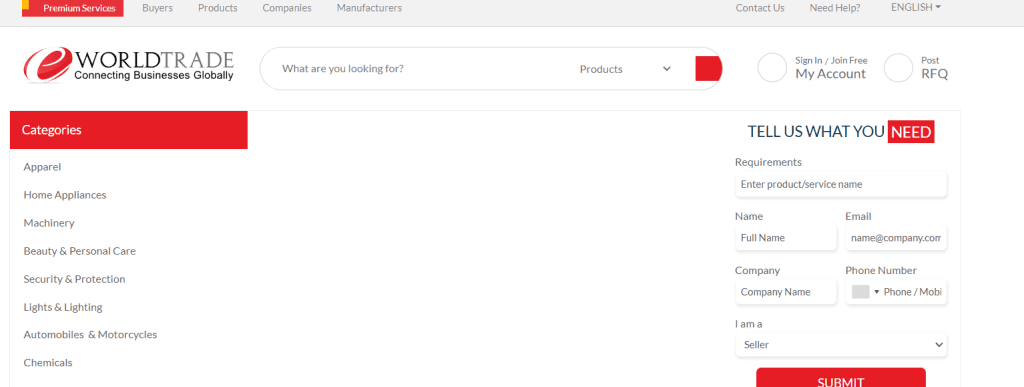
2. Alibaba
Another well-known online B2B marketplace where suppliers and manufacturers can connect is Alibaba.
A private Chinese platform with a 9.9 trillion GMV is anticipated to increase by 18 trillion yuan in 2023.
The goal of Alibaba is to grow their company and simplify commerce for everyone. It is a well-known international brand that operates in 190 nations.
Alibaba serves as a middleman between suppliers and manufacturers and is an end-to-end trading platform. Verified Main Products, which a product receives after passing the inspection test, is one of Alibaba’s finer features.
They serve a variety of goods, including tools, jewelry, home goods, etc. Alibaba offers flexible pricing and allows for trade without the need for warehouse investment.

3. Amazon Business
Amazon is a helpful platform that allows any company or supplier to reach millions of shoppers and sellers.
It offers a straightforward guideline for joining and is trusted by more than 5 million enterprises.
Amazon provides customers with a resource to find and get in touch with reliable suppliers.
Amazon Business gives its customers access to special price reductions and lets them advertise their programmes and goods. With $19 billion in sales revenue and an estimated $59 billion in product purchases, Amazon is one of the top B2B brands.
One of Amazon’s business’s standout features is its tax exemption, which makes business transactions simpler and helps the company save money.
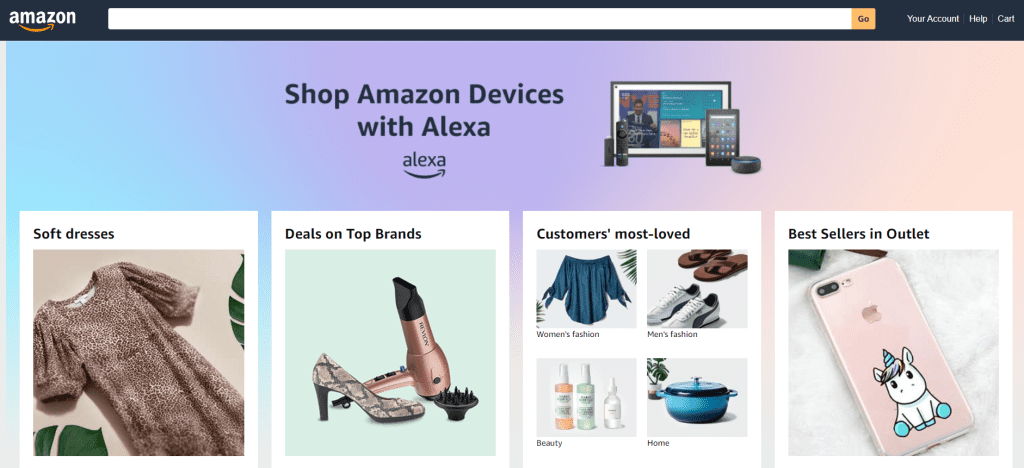
4. Global Sources
A well-known international B2B platform that has been in operation for more than 50 years is called The Global Source.
It is a platform that links several buyers and merchants and was founded in Hong Kong.
They have contributed to the expansion of numerous firms by embracing foreign customers and sellers. the worldwide source claims;
Among the forerunners of the B2B platform are international sources. They are regarded as reliable and intelligent.
The company offers custom solutions for buyers and sellers and welcomes clients from all walks of life.
All platforms, from small firms to household names, are catered to by Global Sources. In the Asian marketplace, it comes highly recommended.
The fact that Global Source is represented at the Hong Kong Trade Fair is one of its many advantages. It shows how well-versed they are in the Western market. Global Sources helps its clients establish a potential reputation in the market while searching for more significant prospects.

5. Made-in-China
It serves as a platform for connecting Chinese buyers with purchasers worldwide. Millions of products are available on their site, and they work with about 17 sectors. Made-In-China was established to serve both big and small businesses. They changed from being a B2C platform to a B2B platform.
Made-In-China was founded to simplify the B2B transaction for both buyers and sellers. One of the characteristics of purchasers is verification; SGS or Bureau Veritas check their position as audited suppliers on the website. The audited suppliers support verification and uphold supplier authenticity.
This market provides excellent services, making it one of the platforms to keep an eye out for. It is a useful platform where one may deal conveniently and securely, and it is expanding quickly.

6. eBay Business Supply
Early in the 1990s, when eBay was established, it was a C2C platform. Today, it is an improved, fully working B2B platform.
They want to embrace and collaborate with retailers to promote growth. One of eBay’s guiding principles is to support and mentor customers at all times.
They have established professional teams because they operate on the principle of teamwork. Over 786 million people have visited their websites. To make commercial transactions simple, they’ve established a database of buyers and sellers.
This year, there are several platforms to pick from, and it is one of the more affordable ones. To aid in the purchase of equipment and connect buyers with lenders, they integrated a financing option for the buyers and sellers.
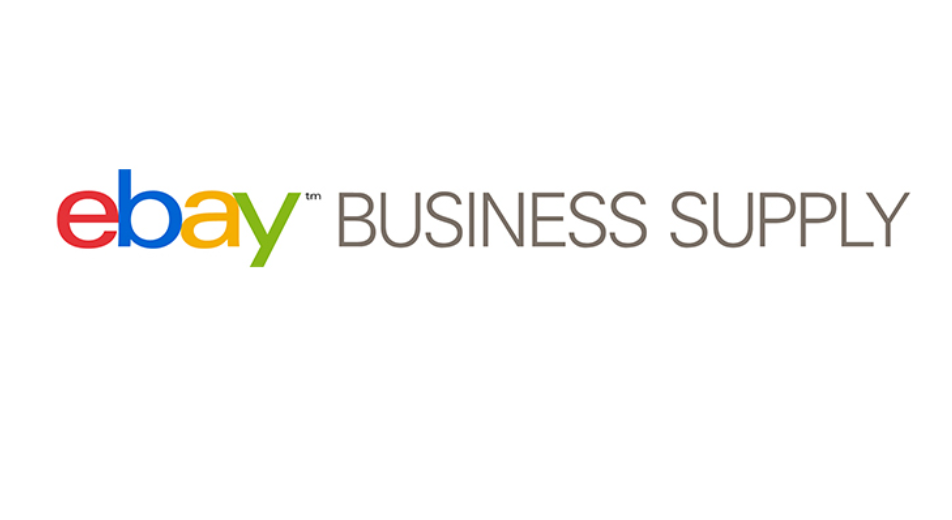
7. ECPlaza
Since it first began operations in 1996, the ECPlaza has been the leading B2B platform for members who are both offline and online.
The company has evolved beyond only operating an online store and now offers EDI services as well as trade consulting. It is the platform that accepts businesses at all stages.
Due to its accommodating policies and business opportunities, EC Plaza has a good reputation.
ECPlaza is the greatest place to go if a business wants to expand and establish a prospective presence in the market. They give their clients renowned services in addition to connecting buyers and dealers.
A “One-Stop Trading Network” is being developed by the futuristic trading platform EC Plaza in order to make trading transactions even more convenient. By easing the trade cycle, the programme will be helpful.
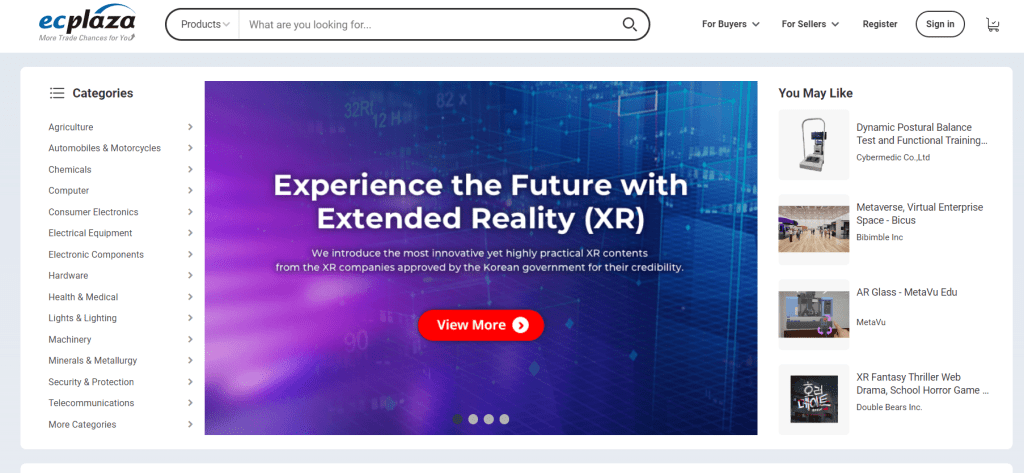
8. EC 21
Another B2B marketplace that has reached the top of the list is EC 21. They currently link with over 2 million members, and their numbers are rising.
The global marketplace operated by the Korean firm links buyers and vendors. They’ve been providing meals and creating chances for small- to medium-sized businesses.
The platform appeals to the audience since it is user-friendly and makes it simple for users to navigate simply entering in keywords.
They have strong brand recognition on the international market due to their technological and trade prowess.
One of EC 21’s most effective features is Buyers Central. They are eager to establish a lasting reputation in the future so that companies can benefit from their expertise.
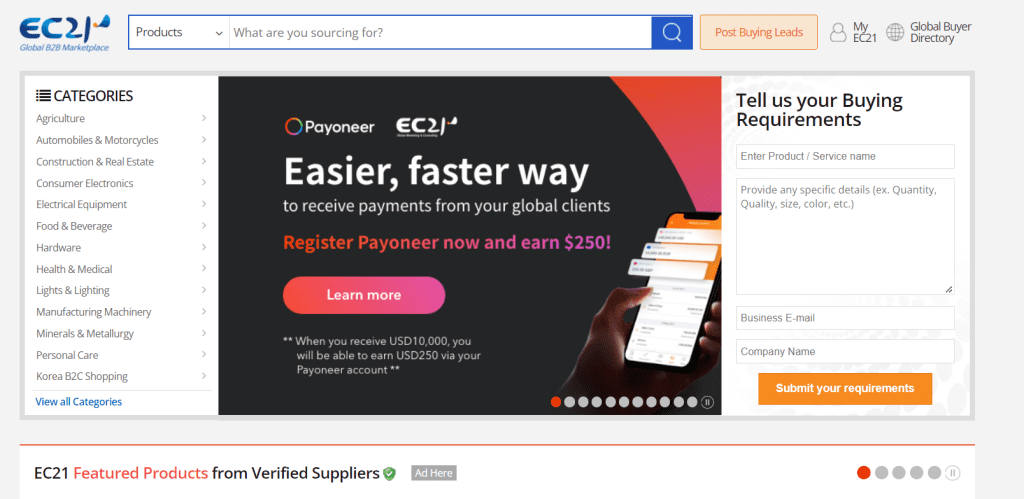
9. AliExpress
At the beginning, AliExpress wasn’t a B2B marketplace. It is a platform designed for small and medium-sized firms that can’t afford to pay exorbitant prices for supplies and goods. They aid in elevating the stature of faltering as well as new businesses.
One of the most reliable places to shop is there. They have a reputable reputation in the trading industry.
They are the primary option of small enterprises and have a global presence. Millions of users from all around the world are welcome to join and collaborate with AliExpress.
They have an efficient website that makes it simple to conduct online transactions. One of the highly regarded brands with safe and secure payment options is AliExpress.

10. Rakuten Marketplace
The fourth-largest e-commerce market in the world is the Japanese platform Rakuten.
They provide their customers with countless opportunities and services. In addition to being an e-commerce site, they also manage internet marketing, credit card payments, and e-reading.
It has about 90 million people who have registered, and in 2023, it will experience a fantastic growth of 1.455 trillion Yuan.
They are upfront in their business practices and provide a very secure environment for online buying.
To make it simpler for the users, they mention their goods and their descriptions. Rakuten excels at what they do and encourages businesses to foster a friendly atmosphere.
They maintain a strong system for customer service and marketing and stay on top of the most recent trends. They have a solid reputation in the industry and give them the ability to ship products directly to warehouses from any location.
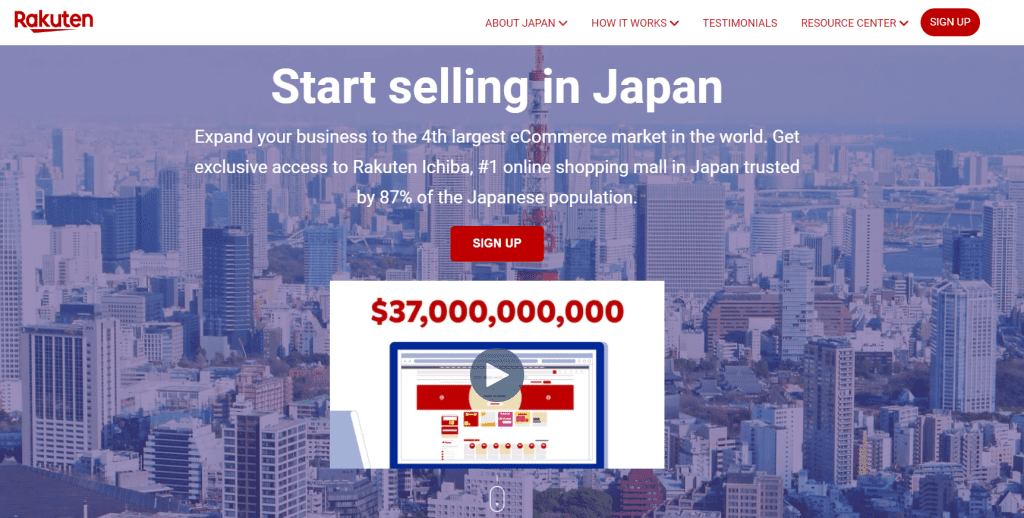
Which are the top B2B ecommerce marketplaces in India?
Research predicts that the B2B eCommerce sector in India would surpass $1 trillion by 2024.
The success of the burgeoning Indian B2B eCommerce market may be attributed to innovative businesses that forged a fresh course for development.
With access to money and financing, B2B companies were able to take advantage of a wide range of new prospects. Several start-ups can be credited for the B2B marketer’s unprecedented growth by providing an online marketplace on their websites, which fueled B2B trade.
To assist the industry develop to where it is today, these eCommerce giants established a B2B ecosystem that was ready to use. Let’s take a look at some of India’s emerging B2B eCommerce marketplaces.
1. Amazon Business
After gaining FDI approval in 2015, Amazon India entered the B2B sector. In India as well as the rest of the world, it is the most reputable brand.
They provide business owners with access to their extensive network of suppliers for simple ordering and huge volume discounts, and they have a high success record in the D2C category. Businesses with a valid business license can join this members-only site, which is presently accessible in Bangalore and Mangalore with ambitions to expand to additional locations.
Features
– Additional discounts and benefits are available to Amazon Business Prime members.
– In collaboration with HDFC Bank and ICICI Bank, provide free credit service (up to 48 days).
– Pricing for businesses and discounts for purchasing large quantities of a variety of products are provided by Amazon Sellers.
– Health and personal care, home medical supplies, beauty, food and beverages, cleaning and laundry, mobile and accessories, office and IT peripherals, and home, kitchen and dining are the main categories offered.
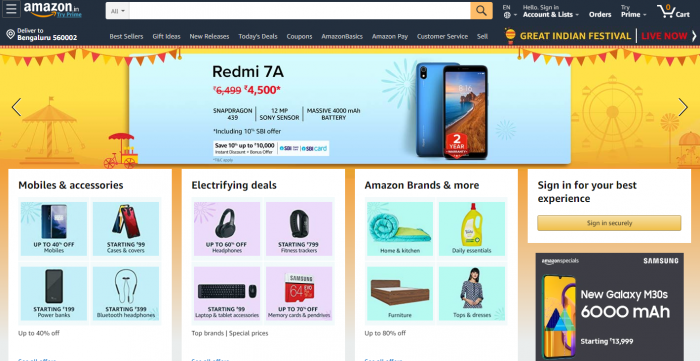
2. Udaan
A B2B trading marketplace called Udaan specifically caters to SMBs in India. In 2016, three former Flipkart employees founded a company with the goal of modernizing trading practices in India.
The portal’s initial focus was on managing logistics for startup companies in the apparel and electronics sectors.
Nevertheless, Udaan quickly began work on creating a full-stack eCommerce marketplace for SMBs in the nation after observing exponential growth. One of the Indian businesses that is growing the fastest is Udaan, which joined the unicorn club.
Features
– It is a multi-vendor marketplace with 25,000–30,000 sellers and a network of over 3 million registered users.
– More than 12,000 pin codes are covered by more than 900 localities and more than 1.7 million merchants, including farmers, kirana shops, HoReCas, and retailers, who conduct more than 4.5 million transactions monthly.
– They have access to credit facilities.
– Serving industries such as lifestyle, electronics, pharmaceuticals, fast-moving consumer goods (FMCG), home & kitchen, staples, hardware & sanitary ware, and toys
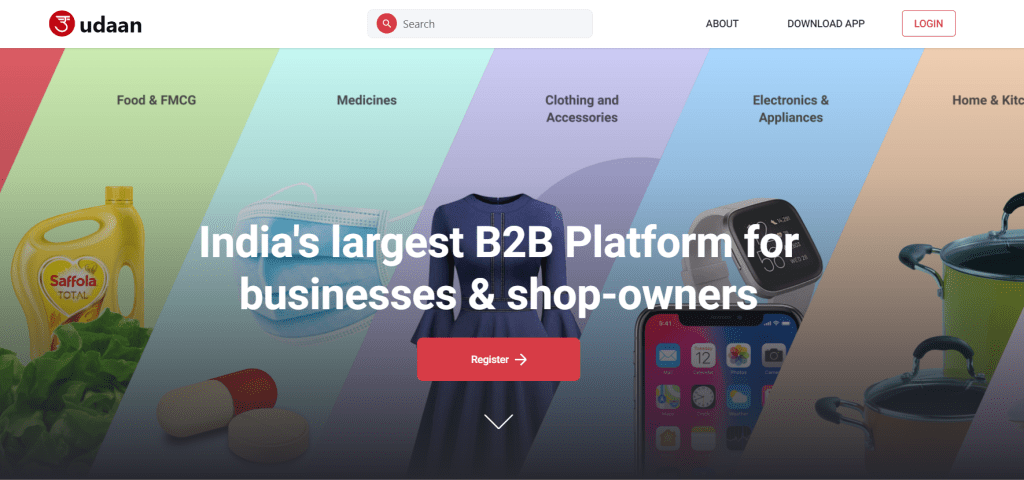
3. Indiamart
Indiamart was founded in 1996 with the goal of “making conducting business simple.” It is a B2B online marketplace where providers and buyers may simply conduct business and gain from one another.
Features
– More than 143 million customers, 7 million suppliers, and 80 million products and services are available.
– In terms of market shares, that’s almost 60%.
– Gives a global audience information on small and medium-sized businesses.
– Permits direct business inquiries from interested clients
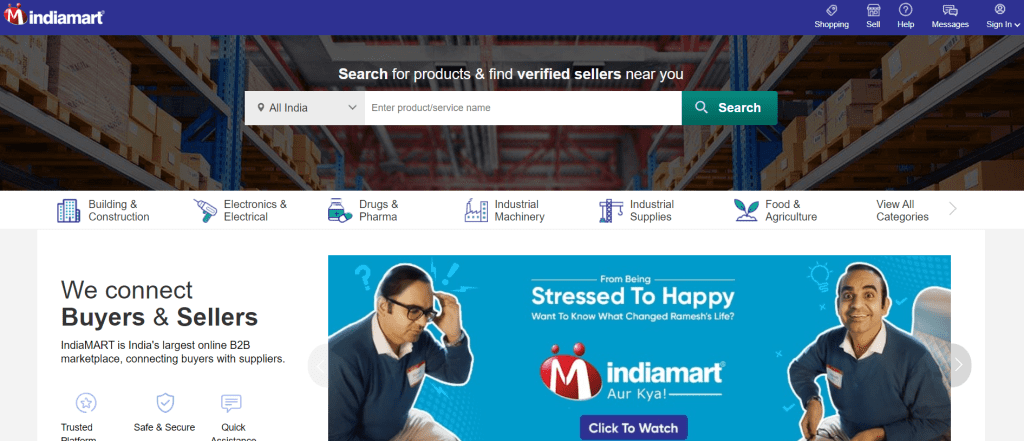
4. JioMart
JioMart is a partnership between Jio Platforms and Reliance Retail. had a soft launch in December 2019 and then a full launch in May 2020.
Their main office is in Navi Mumbai. In addition, they began as a site that exclusively deals with groceries before branching out into fashion, household goods, and lifestyle products. serving almost 200 towns and cities across India.
The app had more than one million downloads within the first week of release.
Features
– Users of JioMart get access to a wide range of groceries and household goods.
– This market provides for both immediate client consumption as well as for companies (kirana outlets).
– Over 750 million people have used the platform as of now.
– Additionally, they offer more than 15,000 SKUs on their platform and deliver to more than 200 cities.
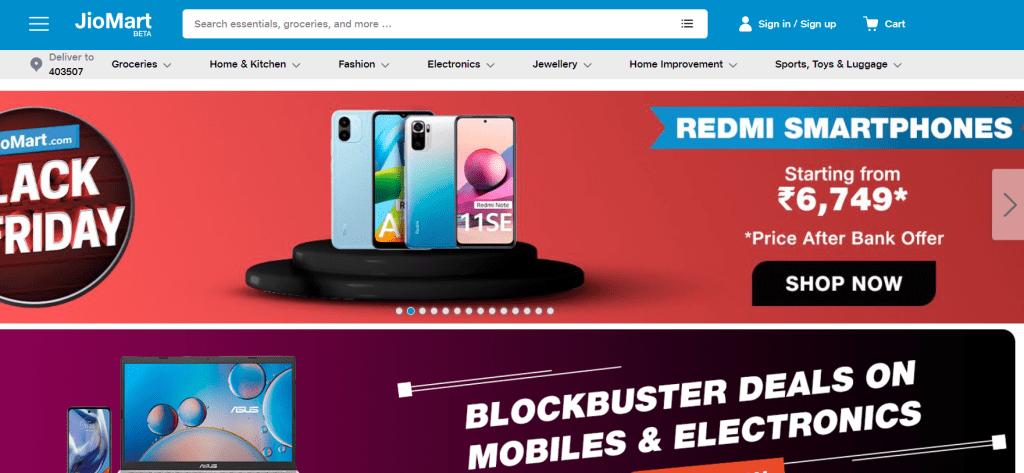
4. Flipkart Wholesale
As its name implies, Flipkart Wholesale was a component of the eCommerce behemoth Flipkart when it was created in 2022.
They want to make it simpler for Indian small-enterprise owners and retailers to conduct business. enabling them to buy goods in bulk and giving them the greatest discount rates. They have their main office in Bangalore and serve every market.
Features
– One B2B marketplace, Flipkart Wholesale, sells all of its goods at a discount.
– Sellers can start placing orders after a simple onboarding process.
– This market serves all product categories, including groceries.
– In addition, they have a positive adaptation rate in 2 and 3 tier cities and serve 1.5 million B2B clients.

5. TradeIndia
In order to link buyers and sellers on a global scale, the TradeIndia website was launched in 1996. to create one of the biggest B2B online marketplaces in India. Indian company owners can interact with traders worldwide with the help of TradeIndia.
Features
– Nearly 4 million buyers and dealers are among the more than 5 million registered members.
– Locating Indian suppliers, manufacturers, and exporters for international buyers.
– Provides advantages to SMBs so they can use their online services, directory services, and trade events to promote their businesses globally.
– They work in the manufacturing and service sectors.
– With more than 12000 product categories and subcategories
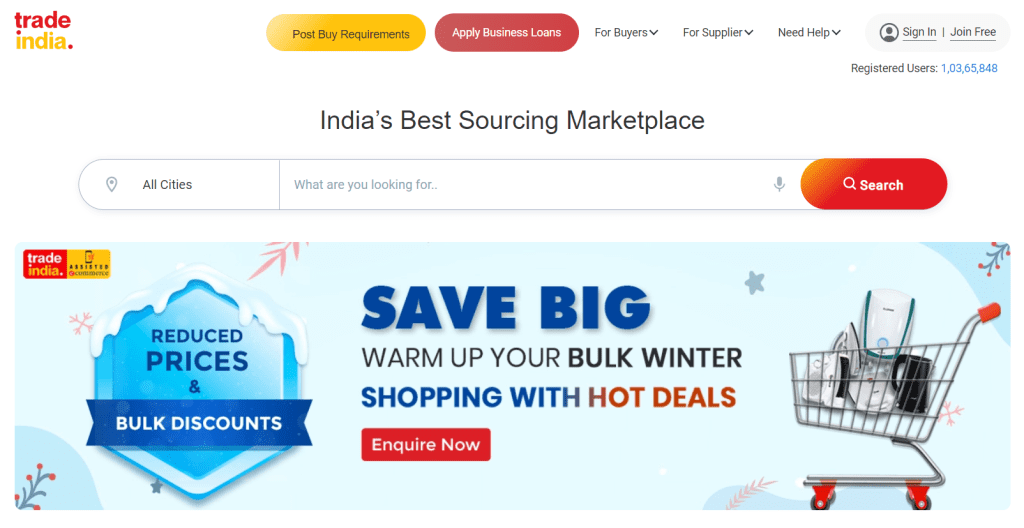
6. ExportersIndia
Exporters India is a B2B multi-seller portal that was established in 1997 and has been onboarding Indian producers and sellers to sell their goods in India and other countries.
B2B eCommerce platforms like ExportersIndia have provided a platform for Indian buyers, sellers, manufacturers, and retailers to connect with enterprises abroad. Additionally, it has been essential in speeding the expansion of Indian eCommerce.
Features
– Free registration is offered to both buyers and vendors.
– More than 14 lakh potential customers.
– Dealing with buyer or seller inquiries directly
– Offers fresh companies 24/7 live showrooms, a large pool of potential customers, prompt responses to inquiries, and exposure to a wider audience all help businesses grow.
– Add up to 400 items.

7. Moglix
Moglix, a business with enormous potential, asserts to be India’s largest eCommerce platform for industrial goods. As the premier Indian industrial B2B platform, it has increased from $1 billion to over $2.6 billion in just eight months.
Features
– More than 500,000 small, medium-sized, large firms it serves
– Manages a network of supply chains with 16,000 suppliers, more than 40 warehouses, and logistical infrastructure.
– More than 700,000 SKUs are available on its platform.
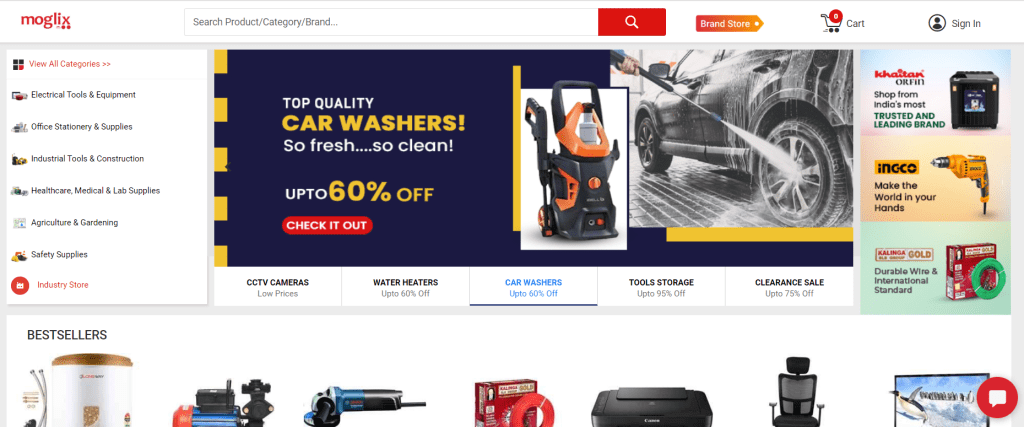
8. Anar.biz (App)
Anar.biz primarily provides services to small and medium-sized businesses along the entire trading chain, from producers to retailers and resellers. The site serves as a communication tool for buyers and vendors.
The company focuses on bringing on businesses from a variety of industries, including jewelry, apparel, groceries, footwear, leather goods, etc.
Features
– Retailers, resellers, wholesalers, distributors, and manufacturers who have registered with the site have the ability to build profiles, upload catalogs, write posts, connect with others, post requirements, and communicate with one another.
– More than 70 million small business owners from 200+ categories utilize a free online store to connect with clients on Facebook and WhatsApp.

9. Ofbusiness.com
OfBusiness is a technologically advanced B2B marketplace that serves as a platform for purchasing for companies in the manufacturing and infrastructure sectors.
It primarily targets SMEs and seeks to enhance the supply chain cycle. This B2B marketplace closes the supply-demand gap for manufacturing goods by bringing buyers and suppliers together on a single platform.
Features
– In India, there are more than 7,00,000 registered SMEs operating in more than 24 states.
– Global reach over more than 35 nations
– They have so far covered more than 100,000 Transactions.
offers SMEs cash-flow-based finance via its NBFC “Oxyzo Financial Services” for the purchase of raw materials.
– 100+ product categories with a promise of low-cost raw materials
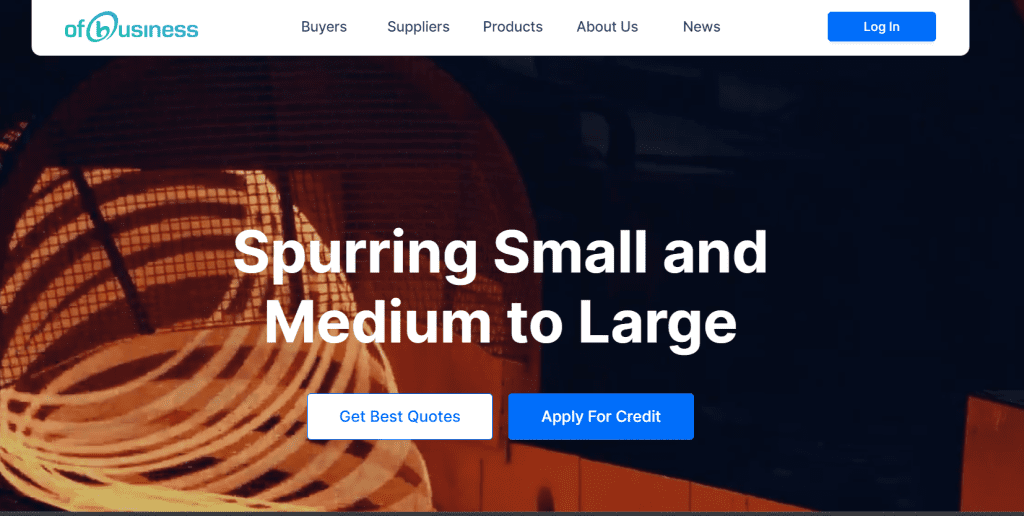
10. Go4worldbusiness
Established in 1997, go4worldbusiness – a B2B marketplace – was set up to provide trade solutions to exporters and importers worldwide.
The trading platform works as an interface where buyers and suppliers connect to broaden their business opportunities. go4WorldBusiness also works with Government bodies and Trade Promotion Councils such as FICCI in India to facilitate international buyer discovery from time to time.
Features
– 1.2 million manufacturers & suppliers across thousands of product categories.
– 20,000 daily inquiries between buyers and sellers.
– Live Chat with Buyers 24×7.

Kilowott empowers companies from across the retail and ecommerce sector, to offer everything from online webstores to tracking solutions that can bolster online selling of your products.
Need help? Let’s talk





